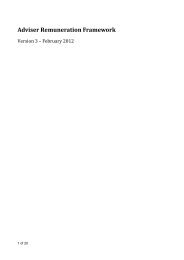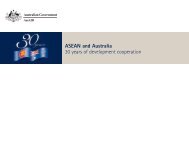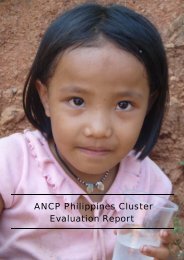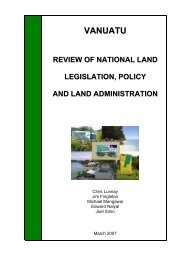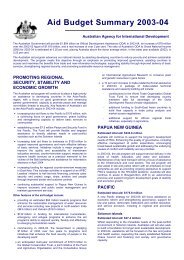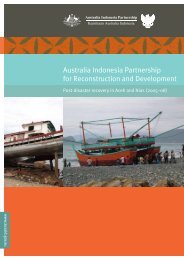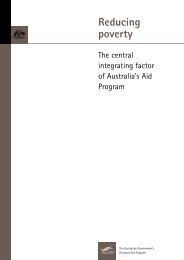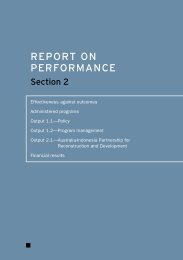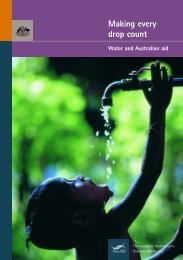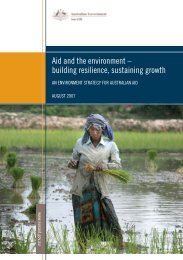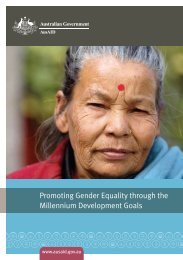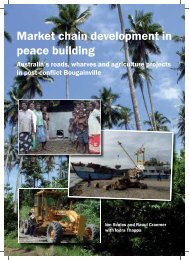In the health sec<strong>to</strong>r <strong>Australian</strong> assistance (over A$250 million sinceindependence) accounts for over 70% of the donor funding received by PapuaNew Guinea. And its sustained focus on primary health and disease controlsuggests <strong>Australian</strong> aid can claim significant credit for improvements in healthstatus that have occurred.As the severity of Papua New Guinea’s budget constraints worsened and itscapacity for service delivery declined, particularly since the mid-1990s, it hasbeen necessary for <strong>Australian</strong> aid <strong>to</strong> focus on preventing further declines inbasic service delivery and living standards. Much of the positive impact ofAustralia’s aid in recent years has therefore been in maintaining infrastructure,equipment and basic services that, in the interests of sustainable development,should eventually be provided by the national government. In theinfrastructure sec<strong>to</strong>r, for example, Australia’s support for road maintenancecovers more than 25% of the national road network, and represents about triplethe amount Papua New Guinea itself has spent. Likewise, a recent health sec<strong>to</strong>rreview has concluded that the main impacts of <strong>Australian</strong> aid in recent yearshave been related <strong>to</strong> preventing a decline in sec<strong>to</strong>r performance that more thanlikely would otherwise have occurred. In essence, Australia has been helping <strong>to</strong>keep a collapsing health system functional.Australia’s assistance for the renewable resources sec<strong>to</strong>r in Papua New Guinea(A$200 million since independence) has covered a very wide range of subsec<strong>to</strong>rs,and has been limited <strong>to</strong> specific priority concerns, making it difficult <strong>to</strong>isolate the impact of Australia’s contribution <strong>to</strong> improved developmentperformance at a higher level. Further, as with activities in other sec<strong>to</strong>rs,broader impacts have not been well documented in individual activity reports.Overall, it appears that <strong>Australian</strong> aid has been carefully targeted <strong>to</strong> addresssome issues of critical importance, and one can infer from the success ofspecific activities that there have been some important positive developmentimpacts. For example, <strong>Australian</strong> aid was instrumental in developing andintroducing cost-effective strategies and technologies <strong>to</strong> deal with the seriousproblem of coffee rust. While objective data on the impact of this are notavailable, these initiatives increased the quantity of coffee produced byplantations and smallholders, presumably increasing the revenue from thisimportant crop.With governance issues constituting probably the most difficult of Papua NewGuinea’s development challenges, Australia’s role in helping <strong>to</strong> strengtheninstitutions, build capacity, support economic reform, promote transparency,accountability and the rule of law, and encourage greater communityparticipation in development and scrutiny of government performance hasintensified since the late 1990s. Of the <strong>to</strong>tal A$540 million provided <strong>to</strong> thisxii The Contribution of <strong>Australian</strong> <strong>Aid</strong> <strong>to</strong> Papua New Guinea’s Development 1975–2000
sec<strong>to</strong>r since independence, 65% has been in the past five years. Prior <strong>to</strong> this,Australia’s role was mainly limited <strong>to</strong> supporting the law and justice sub-sec<strong>to</strong>r,particularly the police force. The recency of most activities, combined with thelong-term nature of capacity building and cultural change associated withimproving governance, means it is not yet possible <strong>to</strong> identify broader impactsof <strong>Australian</strong> aid, nor <strong>to</strong> assess the likely sustainability of the governancereforms being introduced. However, a range of shorter term benefits have beenidentified in this report which, if sustained, are likely <strong>to</strong> contribute <strong>to</strong>improving governance in Papua New Guinea.Based on the report’s assessment of past aid strategies and activities, and thevery limited data available <strong>to</strong> assess broader development impacts, it seemslikely that a number of the recent fundamental changes in Australia’s aidprogram in Papua New Guinea, including in modes of delivery and <strong>AusAID</strong>management structures, are likely <strong>to</strong> yield more tangible impacts in Papua NewGuinea and more rigorous impact assessment within <strong>AusAID</strong>. The IncentiveFund, in particular, is a new mode of aid delivery that offers significantpotential for using incentives <strong>to</strong> motivate behaviour change in Papua NewGuinea, by supporting organisations that demonstrate excellence. Likewise,Australia’s active commitment <strong>to</strong> Papua New Guinea’s Health Sec<strong>to</strong>rImprovement Program and the associated move <strong>to</strong>wards a sec<strong>to</strong>r-wideapproach <strong>to</strong> aid delivery have been critical fac<strong>to</strong>rs in allowing the rapid andsustained growth in health expenditure over the past three years, and havebeen substantially responsible for the recent increase in donor support <strong>to</strong> thesec<strong>to</strong>r. Such approaches in other sec<strong>to</strong>rs could well yield similar benefits.Within <strong>AusAID</strong>, the move <strong>to</strong> in-country program management and theestablishment in Canberra of a specific Design, Impact and Review Sectionshould also improve impact and its measurement.<strong>AusAID</strong>’s capacity <strong>to</strong> undertake rigorous impact assessment is an area thatneeds significant improvement. Since the mid-1990s, Australia’s aid programhas progressively introduced benchmarks and indica<strong>to</strong>rs that would allow theperformance of aid activities <strong>to</strong> be assessed in terms of their broaderdevelopment impact, rather than simply against specific activity outputs.Unfortunately, while appropriate systems and procedures are already in placewithin <strong>AusAID</strong>, these have not been followed. Logical framework matrices areusually well constructed, with appropriate links between performance indica<strong>to</strong>rsand activity inputs, outputs, objectives and broader potential impacts. Inpractice however, suitable baseline data have rarely been collected at the outse<strong>to</strong>f an activity, making ongoing moni<strong>to</strong>ring of impacts and assessment of(particularly quantifiable) progress at this level difficult, if not impossible.Possibly because of this, <strong>AusAID</strong> personnel have not queried the failure <strong>to</strong>The Contribution of <strong>Australian</strong> <strong>Aid</strong> <strong>to</strong> Papua New Guinea’s Development 1975–2000 xiii
- Page 5 and 6: BOXESBox 3.1 The Dutch Disease in P
- Page 7 and 8: FOREWORDAs part of a broader focus
- Page 11: programs to improve living standard
- Page 15 and 16: 1 INTRODUCTIONThis report provides
- Page 17 and 18: Figure 2.1 Real GDP per capita in P
- Page 19 and 20: 1985 1990 1995 2000PNG HPC LIC LMC
- Page 21 and 22: significant strain on the budget an
- Page 23 and 24: • Improved central coordination a
- Page 25 and 26: Connell (1998, pp. 311-2) highlight
- Page 27 and 28: y the successful mobilisation of cu
- Page 29 and 30: 3 INTERPRETING THE DEVELOPMENT ANDG
- Page 31 and 32: The estimated increase in private c
- Page 33 and 34: 3.4 Reconciling the Growth and Deve
- Page 35 and 36: 3.5 Implications for AidTo summaris
- Page 37 and 38: Although the precise extent of the
- Page 39 and 40: program saw a decline in the overal
- Page 41 and 42: criticism that the withdrawal of Au
- Page 43 and 44: Ministerial Forum found that real p
- Page 45 and 46: management for Papua New Guinea, ov
- Page 47 and 48: 5 THE IMPACT OF AUSTRALIAN AID INPA
- Page 49 and 50: • Improved retention rates at sch
- Page 51 and 52: • Achieved operational efficienci
- Page 53 and 54: policing are being introduced, alon
- Page 55 and 56: deliver community and public servic
- Page 57 and 58: BOX 5.5 HEALTH IMPACTS OF AUSTRALIA
- Page 59 and 60: also improved 24 , and there is evi
- Page 61 and 62: 5.5 Renewable ResourcesIn total, Au
- Page 63 and 64:
Land Use Management• Established
- Page 65 and 66:
New Guinea needs donor financing fo
- Page 67 and 68:
only assist within the context of t
- Page 69 and 70:
Both within sectors and more broadl
- Page 71 and 72:
However, it seems reasonable to arg
- Page 73 and 74:
useful to document the findings of
- Page 75 and 76:
ANNEX A EVOLUTION OF AUSTRALIAN AID
- Page 77 and 78:
ANNEX B SECTOR BREAKDOWN OF AUSTRAL
- Page 79 and 80:
8 REFERENCESAhai, N., 1988, The Dev
- Page 81 and 82:
Garnaut, R., and Baxter, P., 1984,
- Page 83 and 84:
Growth Strategy, Final Report, prep



